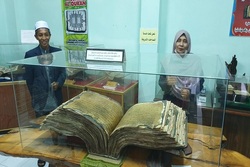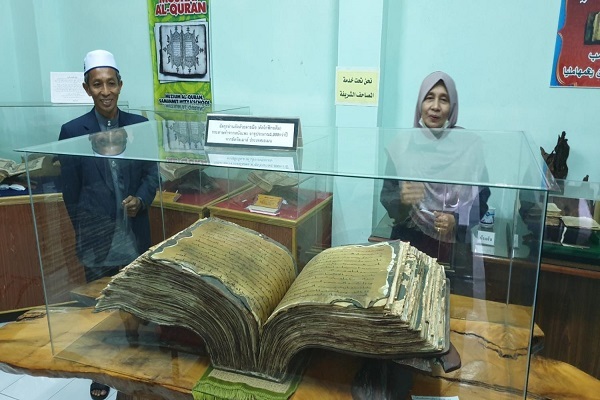Museum of Islamic Cultural Heritage in Southern Thailand Eyes Multiculturalism


The museum, which is slated for an official opening at the end of next year, will provide a window to the far South of Thailand as a multicultural melting pot through the pages of the holy text, observers say.
There is also an Al-Quran Learning Center in the district,
Deputy government spokeswoman Rachada Dhnadirek said the museum will be a centerpiece attraction, pulling in visitors with an appetite to learn about the region's rich history as a pluralist society.
As a special government representative working to tackle problems in the South, Ms Rachada recently took the media on a tour of the region, ahead of a women diplomats event in Pattani, Songkhla and Narathiwat in September and October.
One of the highlights was a visit to the museum, which sheds light on how the South's Muslim population settled in the region alongside Buddhists and mainland Chinese.
Early settlers from starkly different backgrounds lived in peace and harmony.
The museum's construction has progressed rapidly. Its main building now shows off the influence of local architecture and intricate Islamic designs.
The museum's principal feature is the display of old Quran holy scriptures, locked in glass cabinets.
Also exhibited is a method of restoring damaged scriptures by Fine Arts Department-trained artisans.
These technicians are required to have knowledge of various types of barks, papers and parchments.
The museum also contains a large collection of books and old texts set aside for studying the local people's way of life as well as the technologies of bygone eras.
There are also separate Muslim prayer rooms for men and women.
According to museum president Lutfi Haji Samae and Hassami Salae, executive of the Smanmitwithya School in Pattani, the museum houses 79 old Qurans donated by faithful residents.
Mr Lutfi said the story of the museum began with a millionaire from neighboring Malaysia establishing a learning center, complete with a collection of Quran scriptures.
The center piqued public interest in the conservation of Quran texts.
The Fine Arts Department then offered to teach how to correctly restore old scriptures.
Meanwhile, a group of rights advocates from Turkey who visited victims of the 2004 Indian Ocean earthquake and tsunami in Thailand, contributed to restoration efforts.
After that, several locals with old Qurans donated their precious books to museum project officials for restoration.
The books were given new covers and placed in the museum's collection.
Mr Lutfi said Pattani was once a major port city in the 18th century with a trade link to other kingdoms such as Ayutthaya, Srivijaya, Langkasuka and Nusantara.
At the time, the city welcomed voyagers from Egypt, Yemen and Persia who were en route to China, he said.
Old Quran scriptures found in the far South -- estimated to be 150–1,100 years old -- are believed to have originated from Nusantara, India, China, Persia (Iran), Egypt, Yemen, Morocco, Spain, Africa and Uzbekistan.
The age of the scriptures is determined by analyzing their materials, the earliest of which were made of goat skin, predating the use of paper.
The style of Quran scripts and the accompanying design patterns of pages also indicate their age.
A total of 79 Quran texts have been gathered by the museum and are prized for their historical and literary value.
"They are like cultural maps that transport people back to the old Muslim world," Mr Lutfi said.
Currently, the museum is in its soft opening stage, which has attracted approximately 160,000 visitors so far, he said.
He added with the recent normalization of diplomatic relations with Saudi Arabia, the museum expects to welcome more visitors from the Middle East.
Mr Lutfi and Ms Hassami agreed that the museum puts across a message of longstanding peaceful coexistence between locals of different faiths, including Muslims, Hindus and Buddhists, in the area.
Today, the effects of interfaith harmony can still be seen.
Songkhla's Wat Tham Talod in Saba Yoi district displays a blend of religious designs stemming from the Ayutthaya period and southern art.
A Malay merchant has also commissioned the casting of a Buddha statue that is respected by all residents.
In some communities in the district, residents agreed to let Muslims and Buddhists take turns serving as village head.
Ms Rachada said the beauty of tolerant, inter-cultural living should be showcased for everyone to see and witness through tourism.
The Thai government is ready to support such programs to revive the tourism industry in the far South, which has been battered by the COVID-19 pandemic, she said.
Source: bangkokpost.com



